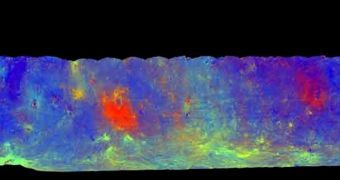Since arriving in orbit around the giant asteroid Vesta, in mid-July this year, the NASA Dawn space probe changed two observations orbits. This allowed it to compile interesting maps of the largest asteroid in our solar system, showing it to be more geologically diverse than researchers first estimated.
The large space rock is about 529 kilometers (328.7 miles) in diameter, and astronomers believe that it is a protoplanet. This means that it may have grown into a fully-fledged planet, just like the other four rocky worlds in the inner solar system, had not other cosmic events stopped its growth.
Advanced scientific instruments aboard Dawn reveal the surface of Vesta in spectral colors, showing the complex geological makeup of the asteroid. These minerals are represented in this image in false-color, so that the contrast between them becomes more apparent to the untrained eye.
In optical wavelengths, the asteroid appears to have a uniform, gray color, but geologists know better than to trust what their eyes are seeing in optical wavelengths. Before moving away from Vesta, in July 2012, Dawn will occupy two more orbits around Vesta, collecting more data on the space rock, ScienceNow reports.

 14 DAY TRIAL //
14 DAY TRIAL //